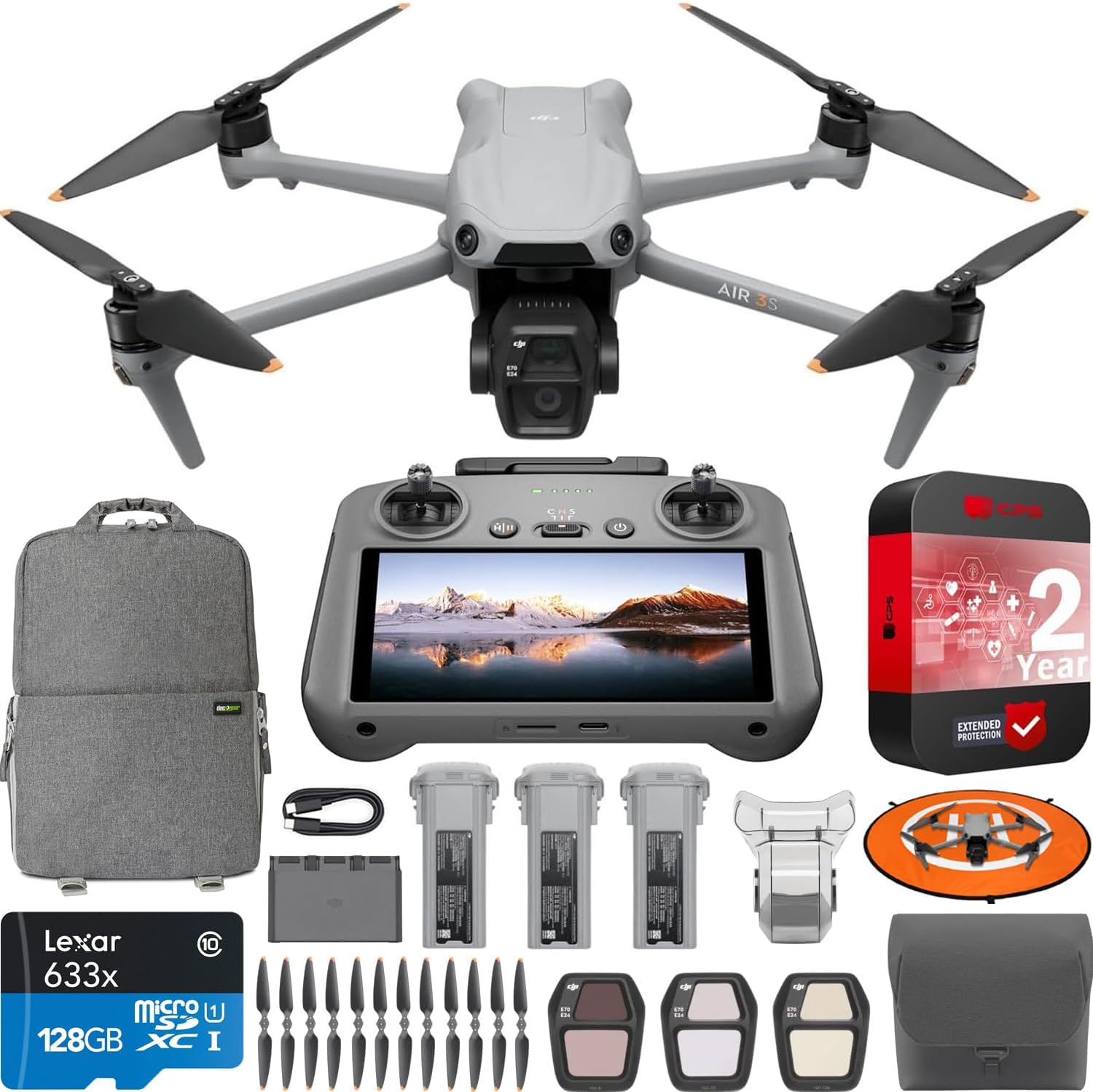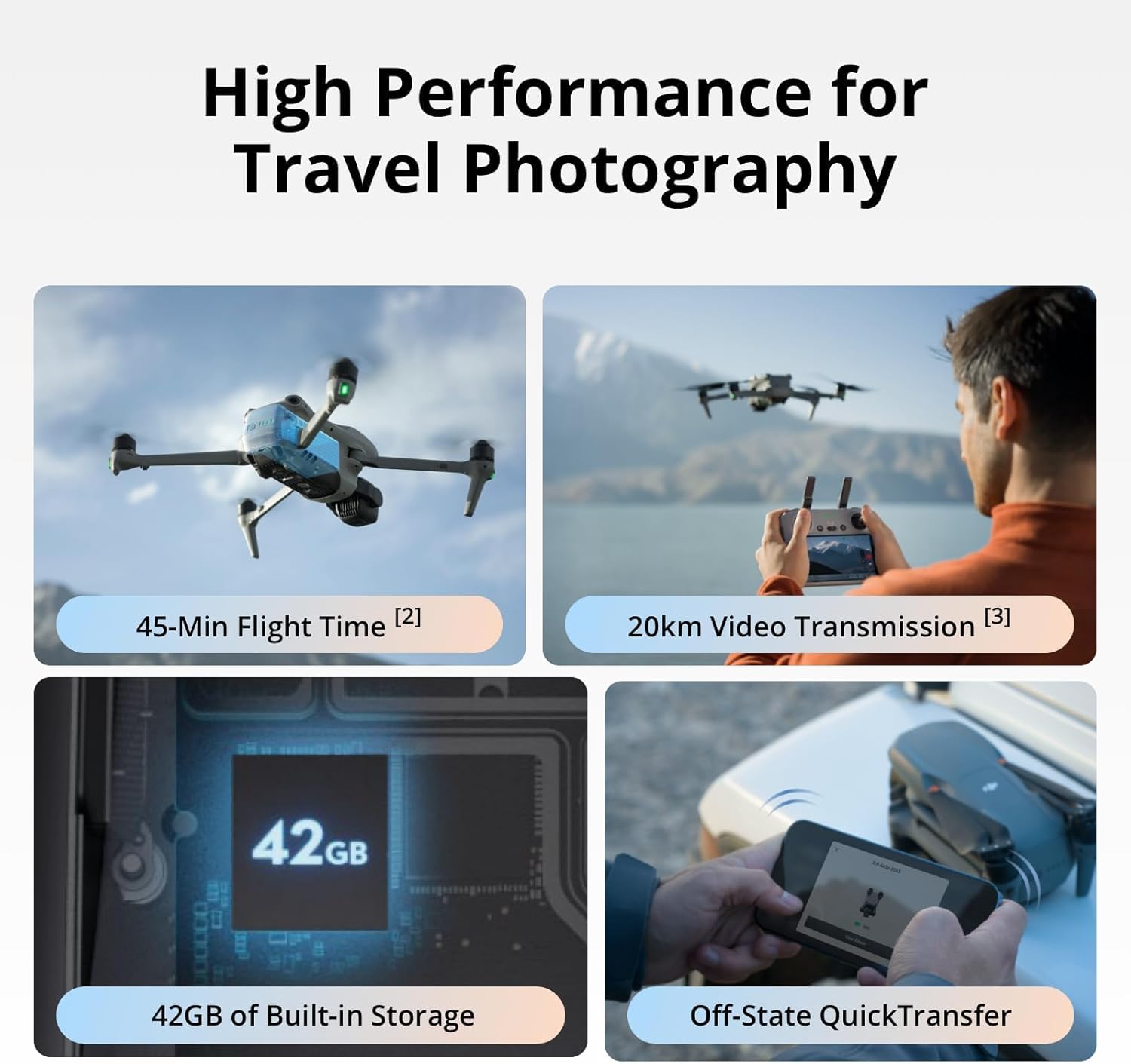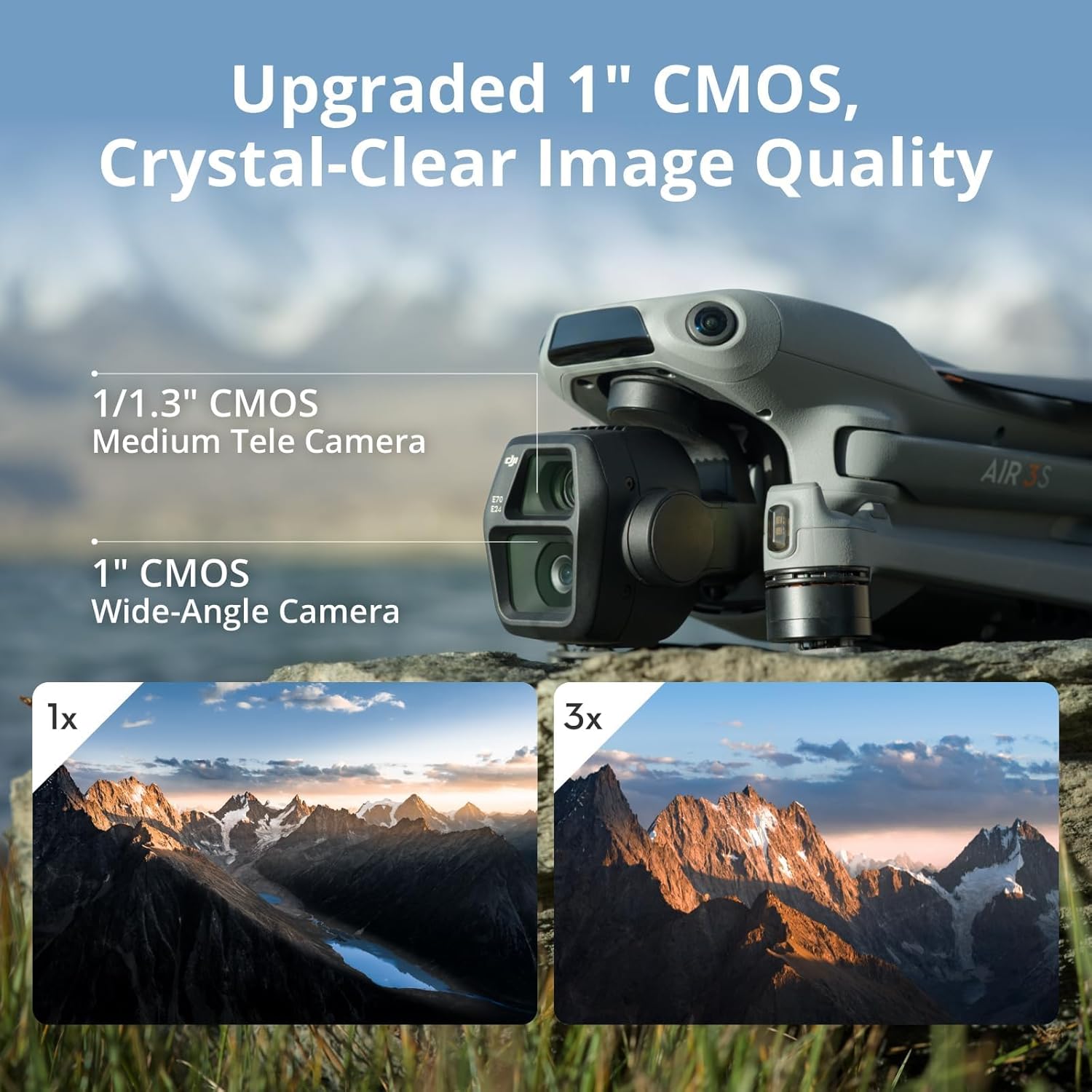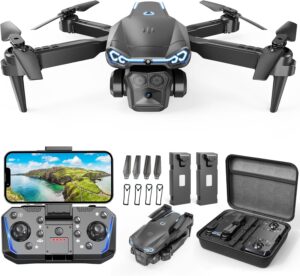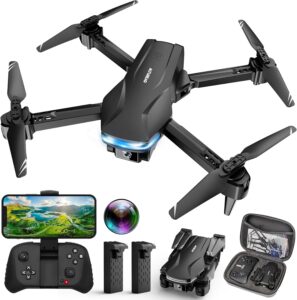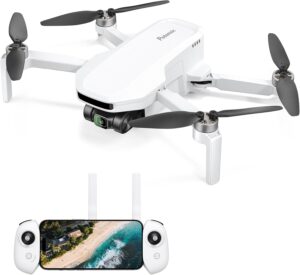Are we really the sort of people who look at a sunset and think, “This could use ND32”?
What We’re Reviewing
We’re spending time with the DJI Air 3S Fly More Combo (RC 2 Screen Remote Control) Drone with 1″ CMOS Wide-Angle & Medium Tele Camera, 4K/60fps, Omnidirectional Sensing, Smart RTH & 3 Batteries Bundle with Deco Gear Accessories. It’s a mouthful, and thankfully it’s also an armful—in the best way. We get the aircraft, the RC 2 screen remote, three batteries, a charging hub, ND filters, a shoulder bag, and then even more extras from Deco Gear including a backpack, a landing pad, and a 128GB microSD card.
We’re not just here for a spec sheet. We’re here to find out if this combo makes our footage look less like a wobbly vacation video and more like something we’d send to a relative as proof we’re thriving.
First Impressions and Unboxing
We opened the box and immediately felt that patient hush of an object that’s been designed by people who measure twice and cut once. Everything has its place: the aircraft tucked into protective foam, the RC 2 remote gleaming like a pocket television from a better, brighter future, and the accessories arrayed as if we’d been planning a mission instead of a weekend away.
We appreciate that this is a real “fly more” combo. The third battery turns a quick outing into an afternoon, and the charging hub encourages good decisions, which is rare in our lives. Then the Deco Gear extras pile on practical convenience—because nothing says “we’ve got this” like a landing pad you can spot in tall grass.
The Bundle at a Glance
We always like to see what we’re actually getting, so we made ourselves a tidy map of the included gear and what it’s useful for. It kept us from accidentally throwing out something important with the bubble wrap.
| Item | What It Is | Why We Care |
|---|---|---|
| DJI Air 3S Aircraft | The drone itself | Dual-camera system with a 1″ CMOS primary sensor for serious image quality. |
| DJI RC 2 Remote Controller | Screen remote | Built-in display means no phone juggling; better visibility outdoors. |
| 3 Intelligent Flight Batteries | Power units | Three batteries unlock real shoot flexibility and stress-free retakes. |
| Battery Charging Hub | Multi-charger | Efficient charging and organization for the battery buffet. |
| ND Filter Set (ND8/32/128) | Neutral density filters | Controls shutter speed in bright light for cinematic motion. |
| DJI Shoulder Bag | Carry case | Grab-and-go convenience for short outings. |
| 3 Spare Propellers | Extra props | Because curbs, branches, and hubris happen. |
| Type-C to Type-C PD Cable | Power/data cable | Fast charging and transfers without rummaging around. |
| Gimbal Protector | Gimbal lock/guard | Protects the most delicate part during travel. |
| CPS 2 Year Extended Warranty | Extended coverage | Extra peace of mind beyond the standard warranty. |
| Deco Gear Drone Photography Travel Backpack | Larger carry solution | Space for the full kit plus extras for longer trips. |
| Deco Gear 31.5″ Landing Pad | Portable landing zone | Keeps the intake clear of grit and grass; easy visual target. |
| Lexar 128GB 633x microSDXC Card | Storage | Ready-to-fly capacity for 4K/60 HDR footage on day one. |
Build Quality and Design
We like how compact it gets when folded and how confidence-inspiring it feels when unfolded—like a camping chair we can actually trust. The arms lock open with a satisfying solidity, and the gimbal protector does its job without turning into a puzzle each time we remove it.
There’s a seriousness to the build, the kind that whispers “take me somewhere with a horizon.” It feels like a travel companion we won’t have to apologize for, even if we’re the type to trip on flat ground.
The Cameras: Wide-Angle and Medium Tele
What sets the Air 3S apart is the dual-camera arrangement: a 1″ CMOS primary camera for wide-angle shots and a medium tele companion for tighter framing. It’s like having two moods—one for the sweeping vista, another for a private conversation with a rooftop or a distant lighthouse.
We used the wide camera for landscapes and the medium tele when we wanted to emphasize a subject without flying too close. It kept our compositions honest and our rotors far from things that scuff. Switching is quick and keeps us in the creative flow.
Image Quality: 4K/60fps HDR and 14 Stops of Dynamic Range
The 4K/60 HDR video is the kind of spec that sounds great on paper and then, to our relief, looks wonderful on screen. Being able to shoot HDR with up to 14 stops of dynamic range helped us hold onto highlight details in late-afternoon clouds while keeping shadowy forest edges from turning into a guessing game.
We noticed that sunsets look like sunsets and not pastel approximations. We don’t need to bully our files in post to recover stretched highlights; the drone gives us workable footage, and our editing timeline thanks us with fewer angry spinning wheels.
Low-Light and Nightscapes
The 1″ CMOS sensor is the hero at dusk, which is when we usually remember to get beautiful shots. We’re the sort of people who think “five more minutes” applies to light, and then we end up rushing. Even as the sky deepens, the Air 3S keeps texture in the shadows and shape in the highlights.
We still mind our ISO choices, of course, but we can shoot moments we used to miss. The result: nightscapes and city scenes that carry mood without becoming grainy confessions. It makes us braver without getting sloppy.
Free Panorama Mode
We have a soft spot for panorama mode because it lets us act like a patient person. The Air 3S stitches frames into wide, seamless panoramas. With the wide-angle camera, we get generous vistas that feel true to the scene. Switch to the medium tele, and we get less distortion and more detail on distant subjects.
The joy here is that it’s all handled in-camera. If we want to get fancy later, we can always re-stitch from the source, but for social posts or quick shares, the built-in results more than hold up.
Flying Experience
Flying the Air 3S feels reassuring. It’s responsive but not twitchy, like a driver who uses turn signals out of genuine politeness. We get precise control for slow, cinematic moves, and enough speed to reset for another pass before our subject starts looking bored.
The RC 2 screen remote is the kind of upgrade we don’t want to go back from. Not needing a phone frees up mental space, and the display is bright enough that we don’t spend the flight squinting or making a visor out of our hands.
Omnidirectional Obstacle Sensing with Forward LiDAR
With omnidirectional obstacle sensing and forward-facing LiDAR, the Air 3S can see the world in a way that feels almost spooky, in a comforting way. It maps its surroundings and avoids collisions without demanding constant oversight. We still fly responsibly, but we also breathe more often.
At night, those sensors earn their keep even more. As daylight vanishes, the drone remains aware of the world around it. We let it skirt buildings while we keep our shots lined up, and the net result is footage that looks intentional instead of lucky.
Smart Return-to-Home
Return-to-Home is one of those features we pretend we’ll never need until we do. The upgraded Smart RTH on the Air 3S chooses an intelligent route back, even when the GPS signal is less than heroic. It’s like asking a local for directions who actually knows where the road work is.
We tested RTH in a spotty-signal area, and it behaved like a careful homing pigeon, picking the best path without drama. It’s peace of mind we felt in our shoulders.
Transmission and RC 2
A 20 km video transmission range means we have more than enough elbow room. We’re not flying out to the horizon, but the signal quality is remarkably stable and the image on the RC 2 display stays crisp even as we dance around trees and buildings.
The remote itself is a pleasure to use. It has the right heft and a layout that doesn’t put key buttons where our fumbling thumbs might cause mischief. The built-in screen turns setup time into a coffee break instead of a phone-connecting ritual.
Battery Life and Power Management
We’ve made peace with our attention span, and the Air 3S meets us where we’re at. With a max flight time of up to 45 minutes per battery (under ideal conditions), we get a generous stretch per flight. In practice, we plan conservatively and still find we have enough minutes to compose thoughtfully and try a second angle.
The included charging hub slots three batteries neatly and cycles them efficiently. We charge while we pack, and by the time we’re out the door, the set is topped off. We label our batteries so we rotate usage evenly, which makes us feel organized in a way our sock drawer never will.
ND Filters: Why and How We Use Them
We like our motion to look like motion, not a strobe-lit dance floor. The included ND8/32/128 filters help us keep our shutter speed in a cinematic zone even in bright daylight. ND8 handles mildly sunny days, ND32 is great for noon-ish brightness, and ND128 is for ruthless sunlight on reflective surfaces.
We slide the filter on, keep the shutter around double the frame rate, and let the footage breathe. We also experiment, because sometimes life looks better at 1/4000 too, and we’re not purists—we’re just trying to make the waves look like waves and not confetti.
Accessories in the Deco Gear Bundle
We’re fond of the Deco Gear backpack because it swallows the entire kit and still has room for snacks. The straps are comfortable, the compartments make sense, and the zippers don’t play coy. For a longer day, we pick the backpack; for a quick sunset run, the DJI shoulder bag is just right.
The landing pad feels like the drone equivalent of a welcome mat. It gives us a clean spot to lift off and touch down, and it’s surprisingly helpful for focusing our preflight routine. We stop, think, check, and start. Our ankles appreciate not crouching into mud.
Storage and Workflow
The Lexar 128GB microSD card gets us through a day of 4K/60 HDR shooting without micromanaging clips. We still carry a spare card (or two), but it’s nice not to watch the counter like a hawk. Back at the desk, we copy to a project folder and a backup drive before we touch anything—past mistakes taught us that much.
We keep our footage organized by date and location, which has saved us from a treasure hunt more than once. We also format the card in-camera before big shoots, because we’re not trying to test our luck in parking lots.
Safety, Regulations, and Night Flight Notes
We keep our flights legal and polite. That means checking local regulations, registering the aircraft if required, maintaining visual line of sight, and respecting privacy and no-fly zones. Night flight requires extra caution; we make sure we can always see and orient the drone and keep our routes predictable.
The Air 3S’s sensors help, but they don’t replace common sense. We avoid areas with dense obstacles after dark and stay well within our comfort zone. The best footage is the footage we bring home.
Performance in Real-World Scenarios
In travel situations, we found ourselves shooting more establishing shots with the wide camera and switching to the medium tele for details—church spires, street murals, tiny fishing boats that look like they’re telling a story. The combination gave our edits rhythm.
For real estate and property work, the medium tele lends polish without requiring uncomfortable proximity. The wide camera then steps in for hero shots that show off the whole space. It’s a nice one-two arrangement when we want to look like we did this on purpose.
Wind and Weather
We’re not flying in storms, but the Air 3S holds its attitude nicely in gusts. Our horizon remains level, and our footage stays usable. We still check forecasts and bring a microfiber cloth for the lens—salt spray and pollution aren’t friends to glass.
Temperature-wise, we baby our batteries when it’s cold or very hot. We let them warm up a touch in winter and cool down between flights in summer. The drone rewards that care with consistent performance.
Audio and Props
There’s no onboard soundtrack, unless you count the whirr of the propellers. We keep earplugs in our bag for windy days when the buzz feels louder, and we bring the spare propeller set just in case. Slightly bent props can sneak artifacts into footage, so we swap them at the first sign of misbehavior.
We also carry a small screwdriver and a soft cloth; props and fingerprints have a way of intersecting at the worst moments.
Who Is It For?
We thought about the kinds of shooters who’d love this kit and the reasons why. Then we organized that thinking before it wandered off to get snacks.
| User Type | Why This Kit Works | What We’d Highlight |
|---|---|---|
| Travel videographers | Compact, long battery life, dual camera flexibility | 1″ sensor for low-light cities and sunsets; backpack for real travel days. |
| Real estate and property shooters | Medium tele for detail, wide for exteriors and landscapes | Quick panorama mode for dramatic listing shots. |
| Content creators and social teams | 4K/60 HDR for platform versatility | Built-in screen remote for faster setups and fewer cable gremlins. |
| Hobbyists leveling up | Safety features and Smart RTH reduce stress | Three batteries make practice sessions productive. |
| Documentary shooters | Discreet footprint, reliable transmission | Omnidirectional sensing for safe shots near structures. |
Comparisons and Buying Considerations
If we had to place the Air 3S on a map, we’d say it balances image quality, portability, and safety nicely. Compared to smaller drones, the 1″ CMOS primary camera pushes low-light and dynamic range further, which matters during the golden hour when the world actually looks good. Compared to larger, heavier rigs, the Air 3S keeps the footprint manageable without demanding a second mortgage.
If you mostly shoot in perfect light and need the lightest possible pack, a smaller model might do the trick. If you’re chasing the maximum in sensor size and lens options, you’ll be eyeing the top-tier flagships. But we think the Air 3S hits that sweet spot where we feel professional and nimble at the same time.
Setup Tips and Camera Settings We Love
We’re not big on rules, but we like guidelines that keep our footage consistent and our nerves calm. Here’s what we find ourselves doing most often to get reliable, cinematic results.
- Update firmware at home on Wi‑Fi, not in a windy parking lot.
- Format the microSD card in-camera before major shoots.
- Set RTH altitude generously above local obstacles.
- Enable histogram and overexposure warning on the RC 2 screen.
- Use ND8 on slightly bright days, ND32 on full sun, ND128 for harsh mid-day or reflective water/snow.
- Keep shutter speed near 1/120 for 4K/60 when motion should look natural; adjust with ND.
- Shoot HDR when the scene has big contrast swings (sunrise, sunset, backlit architecture).
- Use Tripod/Cine modes for slow, deliberate moves when we’re near subjects.
- Assign a custom button to gimbal re-center—it cuts down on frantic scrolling.
- Calibrate the compass and IMU when prompted; don’t postpone like a dentist appointment.
For panoramas, we prefer to lock exposure before starting the stitch, so the sky doesn’t adopt multiple personalities. We shoot a safety wide shot afterward, just in case we later decide we liked simple better.
Troubleshooting and Gotchas
We’ve learned a few things by doing them the wrong way first, and we’re happy to let you skip those chapters.
- If the RC 2 screen looks dim, check the brightness setting; it can be manually turned down.
- If your horizon drifts slightly after hard turns, run a gimbal calibration when you land.
- If you see a microSD speed warning, test with another card; then consider lowering the recording bit rate or format, and keep cards freshly formatted.
- When GPS lock takes longer, wait an extra beat—launching impatiently can result in inaccurate home points.
- Set a conservative low-battery return level. We prefer to come home with margin instead of negotiating with our past self.
- Obstacle avoidance at dusk does wonders, but reflective surfaces like glass and water can still confuse any system; keep your routes sensible.
- Always reattach the gimbal protector before packing. Loose items in a bag plus an unprotected gimbal is a recipe for regret.
Value and Warranty
We love that this is a DJI USA Authorized package with a full USA warranty, plus a 2‑year CPS Extended Warranty. Warranties aren’t romantic, but they are reassuring. Combined with the robust accessory set, we’re stepping out the door with everything we need and fewer excuses.
If we price out comparable kits piece by piece, this bundle stacks up favorably. The extra batteries are non-negotiable for serious outings, the ND set saves a separate purchase, and the Deco Gear accessories make the whole system practical from day one.
The Cameras, Revisited: What the 1″ CMOS Sensor Changes for Us
We keep circling back to that 1″ CMOS primary camera. In scenes where light gets dramatic—city lights at blue hour, alpine slopes under a receding sun, boats drifting through dusk—the sensor’s extra headroom matters. It lets us meter for the moment instead of preemptive compromise.
The medium tele camera earns its keep too. We can compress a scene a bit, bring attention to the subject, and keep our edges clean. The result is a set of shots that cut together well without looking like we shot them all from the same stool.
Flight Confidence and Nighttime Caution
We fly more confidently knowing that omnidirectional sensing and forward LiDAR are quietly protecting us from our own optimism. There’s a difference between risk and drama. We like drama in the timeline, not in the flight log.
At night, we triple-check our environment, keep our altitude conservative, and stick to clear lines. The Air 3S helps us manage the unknowns, and we help ourselves by keeping ambition tethered to good judgment.
Making the Most of the RC 2 Screen Remote
We didn’t realize how much friction came from using a phone until we stopped. The RC 2 keeps our hands free and our notifications out of the sky. Composition feels less cluttered when we’re not navigating a home screen before we can take off.
We also appreciate having physical buttons and dials for commonly used functions. It feels like an instrument rather than an app, which is exactly what we want when we’re framing a fast change in light.
Editing and Color Notes
Shooting HDR gives us a pleasing starting point with more room to adjust highlights and shadows. We keep our grade gentle—tiny tweaks often do the most. If we’re putting together social clips, we maintain consistency across shots by syncing a base correction, then nudging each clip rather than reinventing the wheel.
We also save a “look” for specific times of day: a warmer evening preset, a cooler morning one. That’s less about color theory and more about admitting we are creatures of habit.
The Joy of Panoramas, Again
We thought of panoramas as a party trick until we saw how cleanly the Air 3S handles them. Now we use them intentionally: one for context at the start of an edit, or as a celebratory closer. The medium tele panoramas are quietly compelling—they flatten the perspective just enough to present a scene with dignified restraint.
We still shoot a traditional clip after the pano, just so we have motion to marry to the stillness. That pairing feels like breathing out after breathing in.
Handling and Transport
We alternate between the shoulder bag and the Deco Gear backpack depending on the mission. The shoulder bag makes us nimble; the backpack makes us prepared. We dedicate a pocket to filters and memory cards and treat it like a sacred space. When we keep the little things in one place, we waste less light.
The landing pad folds into a circle that refuses to learn origami and we accept that as part of its charm. We stake it down in breezy conditions and enjoy the satisfaction of touching down on a target.
Ethical and Courteous Flying
We always ask ourselves a simple question: if we were on the ground near this drone, would we want it here? That little check keeps us courteous. We avoid hovering near people who didn’t ask for it, we steer clear of wildlife, and we keep our flight paths deliberate.
Good manners make better footage. We don’t have to crop out awkward moments later, and we leave spaces as peaceful as we found them.
Pros and Cons
We tried to balance our enthusiasm with clear-eyed assessment. Here’s where we landed.
-
Pros:
- 1″ CMOS primary camera shines in low light and high-contrast scenes.
- Dual-camera setup (wide + medium tele) expands creative options without changing aircraft.
- 4K/60 HDR with up to 14 stops of dynamic range preserves highlights and shadows.
- Omnidirectional obstacle sensing with forward LiDAR inspires confidence, especially around structures and at night.
- Smart RTH with improved routing, even in weak GPS, reduces stress.
- Long max flight time per battery; three batteries in the box equals real-world endurance.
- RC 2 screen remote simplifies setup and improves visibility outdoors.
- Comprehensive bundle: ND filters, shoulder bag, backpack, landing pad, microSD—genuinely ready to fly.
- DJI USA Authorized with a full USA warranty plus CPS 2-year extended coverage.
-
Cons:
- It’s not the smallest possible drone—if ultralight is your only goal, there are leaner kits.
- HDR grading requires a bit of workflow familiarity to really sing.
- Spare filters beyond ND128 may be needed for niche conditions (e.g., ND16, polarizers), depending on your taste.
- Panoramas are excellent, but consistent exposure locking is a must to avoid subtle shifts.
Little Habits That Make Big Differences
We keep a preflight mantra: props, gimbal, battery, home point. It takes seconds and saves sessions. We also jot shot lists on our phone before leaving the house—then we put the phone away because the RC 2 handles the rest.
We carry a small cleaning kit: lens wipes, a soft brush, microfiber cloths, and a tiny blower. The lens repays every ounce of care with cleaner highlights and less post-production fuss.
Why This Combo Makes Us Shoot More
The real test of any tool is whether it gets used. This kit clears friction at every step. We have batteries for momentum, a screen remote that cuts setup time, filters for noon sun and amber dusk, and protection for the gimbal when our hands get clumsy. It feels like a system built for creative momentum.
We find ourselves making little detours: a stop by the river on our way home, a quick lift-off to capture a neighborhood sunset, a midweek rooftop panorama for no reason other than having the option.
What We’d Add Over Time
We’ll probably add a second microSD card to keep swapping simple, and maybe a variable ND for very specific shooting styles. A small folding sun hood for the RC 2 screen can be nice in brutal sunlight. And we like keeping an extra set of props and a couple of prop screws in the backpack for the “just in case” that eventually arrives.
Beyond that, the kit already feels whole. It’s an honest-to-goodness ready-to-shoot setup.
Final Thoughts
We wanted a drone that made us feel capable without demanding that we become full-time manual-wranglers. The DJI Air 3S Fly More Combo with the RC 2 screen remote, three batteries, and the Deco Gear extras does exactly that. The 1″ CMOS primary camera gives us files that hold up to real editing. The medium tele camera lets us compose with nuance. The safety features and Smart RTH watch our back so we can watch the shot.
More than anything, we’re coming home with footage that looks the way it felt to be there. The clouds have shape. The lights have glow. The motion breathes. And we have enough battery left to do one more pass, just because we finally can.
If our goal is to make more beautiful things with less friction, this bundle meets us right where we live. And yes, we’ve become the sort of people who glance at the sky and think, “ND32.” We’re fine with that.
Disclosure: As an Amazon Associate, I earn from qualifying purchases.
